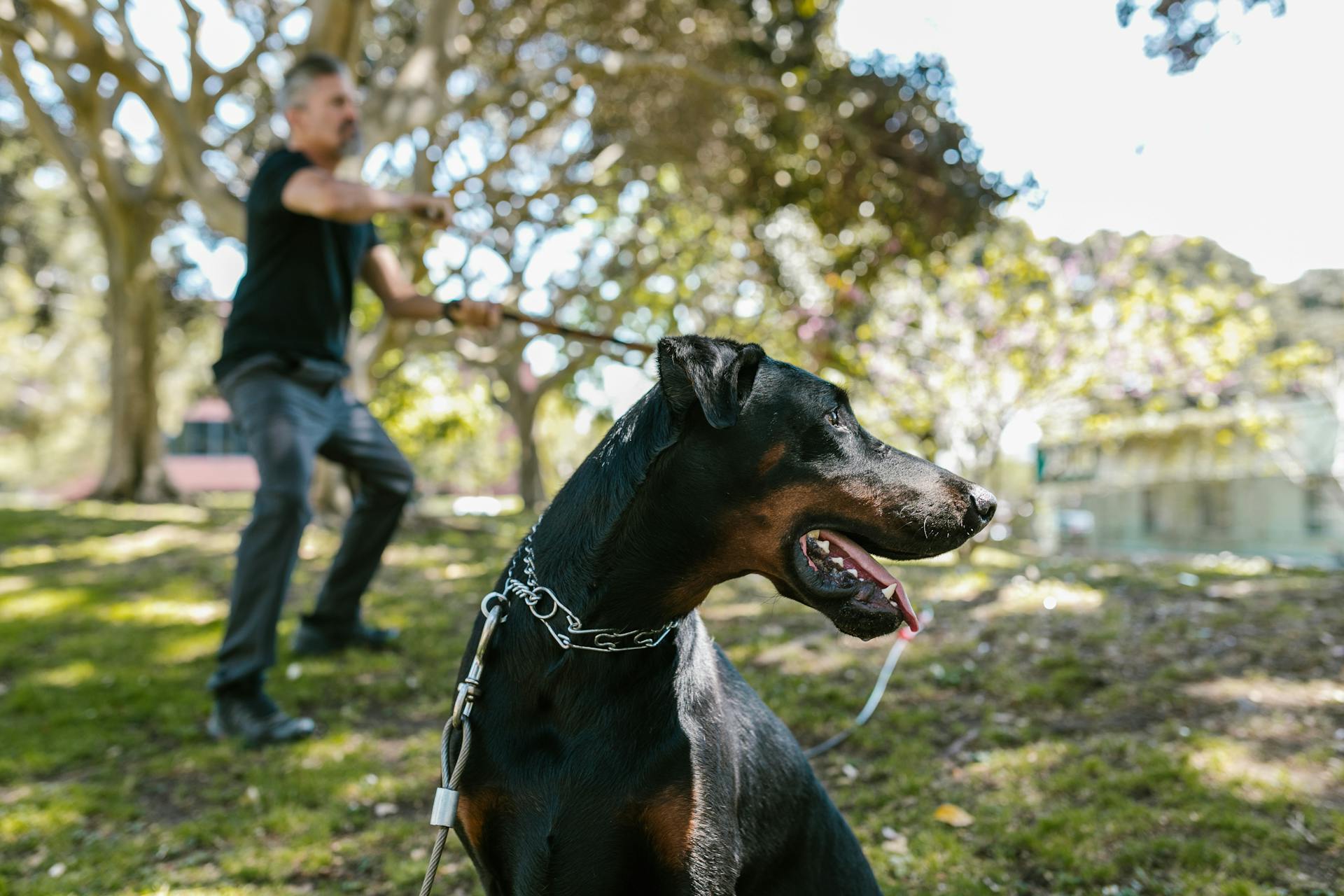
Bilious vomiting syndrome in dogs can be a real challenge for pet owners. It's estimated that up to 25% of dogs will experience it at some point in their lives.
The vomiting is often accompanied by bile, which can be a sign that the stomach is empty for too long. This is because bile is produced in the liver and stored in the gallbladder, and when the stomach is empty, the bile can flow back up into the esophagus.
Dogs with bilious vomiting syndrome may also exhibit other symptoms, such as lethargy and loss of appetite. These symptoms can be distressing for both the dog and the owner, and it's essential to seek veterinary care to determine the underlying cause.
The good news is that bilious vomiting syndrome is often treatable with changes to the dog's diet and feeding schedule.
Intriguing read: Dog Vomiting Yellow Bile
Causes and Symptoms
Bilious vomiting syndrome, or BVS, is a condition that affects dogs, causing them to vomit yellow-tinged fluid in the early morning. This is often the only sign of the condition, but it's essential to pay attention to other symptoms that may arise.
Dogs with BVS typically have good appetites, normal energy levels, and no history of weight loss or diarrhea. They may exhibit other signs associated with nausea, such as lip-smacking or drooling, and panting due to discomfort. After vomiting, they usually feel fine and their appetite returns.
Other conditions can cause dogs to throw up yellow foam, and it's crucial to rule out these possibilities. These include intestinal blockages, acute pancreatitis, irritable bowel disease, intestinal parasites, cancers, infections, allergies, and Addison's disease.
Signs of Illness in Dogs
Signs of illness in dogs can be subtle, but there are some telltale signs to look out for.
Intermittent early morning vomiting is a classic sign of certain health issues, such as Bilious Vomiting Syndrome.
Dogs with BVS may appear otherwise healthy, with good appetites and normal energy levels.
They might exhibit other signs associated with nausea, like lip-smacking or drooling.
A temporary decrease in appetite and panting due to discomfort are also common.
After vomiting, dogs with BVS usually feel fine and return to their normal daytime motility.
Dogs and Yellow Foam Vomiting
Dogs can vomit yellow foam due to various reasons, and it's essential to pay attention to the timing and other symptoms to determine the cause.
Yellow foam vomiting can occur in the early morning, and it's often a sign of bilious vomiting syndrome (BVS). If your dog is otherwise healthy and has a good appetite, this could be a classic sign of BVS.
Other symptoms associated with nausea, like lip-smacking or drooling, may also be present. Additionally, panting due to discomfort and a temporary decrease in appetite can occur.
If your dog displays other symptoms, the yellow foam vomiting could be a component of another problem, and your veterinarian will want to evaluate your dog and run additional diagnostic tests.
Some common reasons for yellow foam vomiting in dogs include intestinal blockages, acute pancreatitis, irritable bowel disease, intestinal parasites, cancers, infections, allergies, and Addison's disease.
Here are some possible causes of yellow foam vomiting in dogs:
- Intestinal blockages
- Acute pancreatitis
- Irritable bowel disease
- Intestinal parasites
- Cancers
- Infections
- Allergies
- Addison's disease
It's crucial to note that with some of these causes, your dog will exhibit more than just vomiting, and they may not feel well after a short period of time.
Diagnosis and Treatment
Diagnosis of bilious vomiting syndrome in dogs is typically suspected in dogs that feel well and simply display intermittent vomiting of yellow bilious fluid, most commonly in the early morning.
Your veterinarian will want to evaluate your dog and run additional diagnostic tests, which could include blood tests and imaging of the abdomen, such as x-rays or an ultrasound. These tests are necessary to rule out other potential problems and confirm the diagnosis.
If your dog displays other symptoms, it's likely that the vomiting is not caused by bilious vomiting syndrome, and your veterinarian will need to consider other possible causes.
Diagnosing in Dogs
Diagnosing Bilious Vomiting Syndrome in dogs requires a careful evaluation, as it's often a diagnosis of exclusion. Your veterinarian will want to run additional diagnostic tests, including blood tests and imaging of the abdomen, such as x-rays or an ultrasound.
The classic sign of BVS is intermittent early morning vomiting of yellow-tinged fluid in dogs that appear otherwise healthy. They will have good appetites, normal energy levels, and no history of weight loss or diarrhea.

If your dog is vomiting yellow bilious fluid in the early morning, your veterinarian will likely suspect BVS. However, if your dog displays other symptoms, it could be a component of another problem.
The dog may exhibit other signs associated with nausea, like lip-smacking or drooling, and panting due to discomfort. They might also experience a temporary decrease in appetite.
Your veterinarian will want to evaluate your dog and run diagnostic tests to rule out other conditions that require a different treatment approach. This is why BVS is often a clinical diagnosis of exclusion.
Treatment
Introducing a late-night meal is often enough to increase gastric motility and solve the problem of bilious vomiting syndrome in dogs.
Feeding a late meal can buffer the bile in the stomach and prevent vomiting, making it a simple and effective solution for many dogs.
However, if your dog continues to vomit yellow fluid even with a feeding schedule change, other treatment options are available.

Promotility drugs or other dietary changes are often successful in managing the symptoms of BVS, according to Dr. Jablonski.
A single dose of promotility drug at bedtime can be beneficial in managing symptoms, but it's essential to consult with your veterinarian for guidance.
Cisapride is a common prokinetic, but your veterinarian can recommend the best option for your dog.
Antacids and medications that increase stomach motility are frequently used to treat BVS, especially if your dog continues to vomit after changing feeding schedules.
A single evening administration of medicine is often enough to prevent clinical symptoms, making it a convenient treatment option.
In some cases, switching to a veterinary gastrointestinal prescription diet can be beneficial in managing symptoms, as Dr. Jablonski suggests.
However, it's essential to note that the success of these treatments is based on anecdotal evidence, as there are limited studies on BVS.
If you're considering over-the-counter treatments, you can try a single dose of Pepcid AC in the evening with a dose of 0.5 mg/kg, but always consult with your veterinarian first.
Frequently Asked Questions
What can I feed my dog with bilious vomiting syndrome?
Feed your dog a low-fat, low-protein diet with easily digestible foods, such as boiled chicken or rice, to help manage bilious vomiting syndrome. Consider dividing meals into small, frequent portions to reduce vomiting episodes.
Sources
- https://www.akc.org/expert-advice/health/bilious-vomiting-syndrome-in-dogs/
- https://pubmed.ncbi.nlm.nih.gov/27008323/
- https://wagwalking.com/condition/bilious-vomiting-syndrome
- https://www.kingsdale.com/bilious-vomiting-syndrome-in-dogs
- https://rotationalmonofeeding.com/bilious-vomiting-syndrome-aka-hunger-pukes-or-bile-vomiting/
Featured Images: pexels.com


